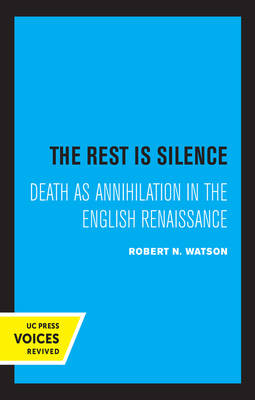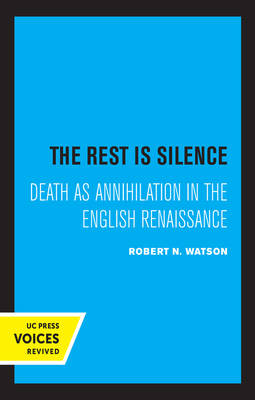
- Afhalen na 1 uur in een winkel met voorraad
- Gratis thuislevering in België vanaf € 30
- Ruim aanbod met 7 miljoen producten
- Afhalen na 1 uur in een winkel met voorraad
- Gratis thuislevering in België vanaf € 30
- Ruim aanbod met 7 miljoen producten
Zoeken
The Rest Is Silence
Death as Annihilation in the English Renaissance
Robert N Watson
Paperback | Engels
€ 84,95
+ 169 punten
Uitvoering
Omschrijving
The Rest Is Silence: Death as Annihilation in the English Renaissance by Robert N. Watson explores how anxieties about death as utter annihilation--rather than passage to an afterlife--shaped English Renaissance culture, especially during the Jacobean era. Watson argues that the Reformation's dismantling of rituals like purgatory, combined with scientific discovery, rising individualism, and schism within Christianity, eroded consolations about immortality and intensified fears of oblivion. This cultural unease surfaces in literature, where plays and poems simultaneously perform the social task of denial and expose its fragility. Shakespeare's tragedies, revenge plays, and comedies probe competing promises of survival--through honor, progeny, or art--only to reveal their insufficiency. Likewise, the metaphysical lyrics of Donne and Herbert wrestle with mortality in forms that both test and shore up Christian doctrine. Watson situates literary representations of death within a broader crisis of belief, where the rhetoric of sermons, funeral practices, and polemics betrays recurring worries about silence, darkness, and the dissolution of self. He challenges critical traditions that assume a uniformly Christian worldview, recovering evidence that annihilationist fears pervaded Renaissance thought even if rarely voiced directly. By combining psychoanalytic insight with cultural history, Watson portrays drama and lyric as stages on which English writers rehearsed strategies of denial, displacement, and consolation in the face of mortality. Ultimately, the book contends that the Jacobean confrontation with death illuminates not only the period's religious and artistic ferment but also enduring human struggles with meaning, selfhood, and the void. This title is part of UC Press's Voices Revived program, which commemorates University of California Press's mission to seek out and cultivate the brightest minds and give them voice, reach, and impact. Drawing on a backlist dating to 1893, Voices Revived makes high-quality, peer-reviewed scholarship accessible once again using print-on-demand technology. This title was originally published in 1994.
Specificaties
Betrokkenen
- Auteur(s):
- Uitgeverij:
Inhoud
- Aantal bladzijden:
- 434
- Taal:
- Engels
Eigenschappen
- Productcode (EAN):
- 9780520325609
- Verschijningsdatum:
- 1/09/2020
- Uitvoering:
- Paperback
- Formaat:
- Trade paperback (VS)
- Afmetingen:
- 148 mm x 210 mm
- Gewicht:
- 562 g

Alleen bij Standaard Boekhandel
+ 169 punten op je klantenkaart van Standaard Boekhandel
Beoordelingen
We publiceren alleen reviews die voldoen aan de voorwaarden voor reviews. Bekijk onze voorwaarden voor reviews.











